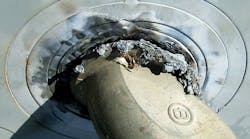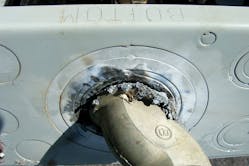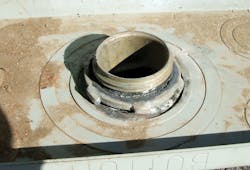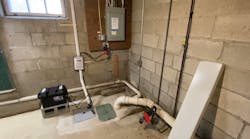All references are based on the 2014 edition of the NEC.
Molten Metal Mess
These photos demonstrate the damage that can occur when ground fault current causes loose connections to arc and spark. Thankfully, there was no damage to the structure from the arcing in this particular situation. Can you imagine what could have happened if this problem had never been found and repaired? It could have been a disaster for the residents living in this building. All of this could have been avoided if the installer had simply tightened the locknut.
In addition to creating a dangerous situation, this loose locknut created a violation of Sec. 250.4(A)(3), since the metal cabinet and raceway were not connected together in a manner that established an effective ground fault current path. Similarly, Sec. 300.10 requires metal raceways, cable armor, boxes, fittings, and metal enclosures to be connected together in a manner that provides “effective electrical continuity.” The photos clearly indicate that effective electrical continuity was lacking for this installation.
The arcing at this locknut connection was so bad that it “welded” the locknut to the offset nipple, and we were unable to remove it. In fact, we pulled the wires out and replaced the entire cabinet due to the extensive damage caused from the arcing.
In Need of a Cover Up
The use of a plaster ring on this box may not have been the best choice of equipment for this installation. This could be a violation of Sec. 110.3(B) if this plaster ring is not designed to be exposed on the surface like this. The use of an exposed work cover may have been the better option here.
The lack of a faceplate on the receptacle is a violation of Sec. 406.6. Receptacle faceplates must be installed to completely cover the opening. The opening around this receptacle is so big that you can see the wires inside the box, and it also leaves the energized receptacle terminals exposed enough to make accidental contact. According to Sec. 110.27(A), live parts operating at 50V or more must be guarded against accidental contact. A person’s fingers could easily come in contact with the terminals on this receptacle, making it a real shock hazard.
The next problem I see is the missing knockout seal on the left side of the box. According to Sec. 110.12(A), unused openings like this must be closed up to afford protection equivalent to the wall of the enclosure itself. Arcs or sparks could easily escape through all of these large openings and ignite nearby combustible materials.







